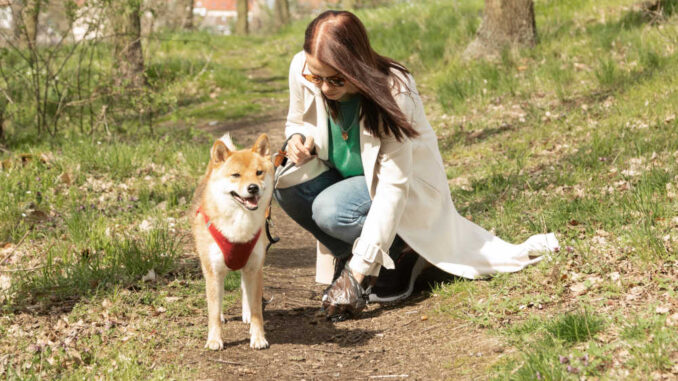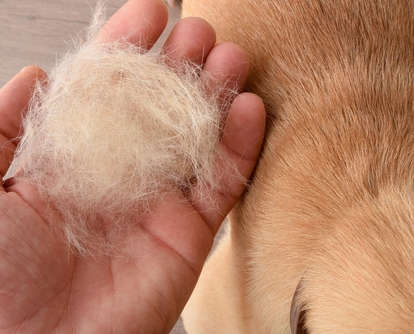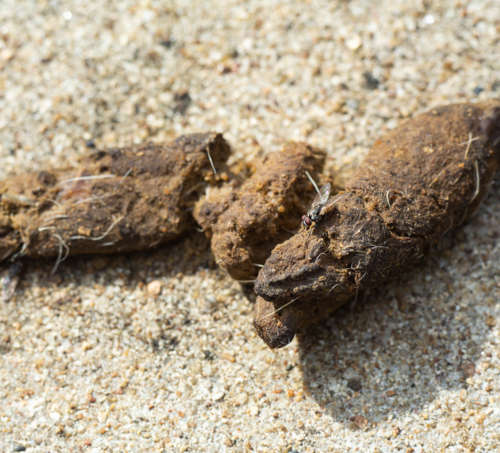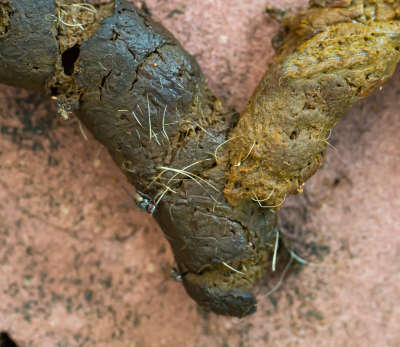
While I deal with this issue much more commonly in cats, there are occasions when an owner will bring their dog in to see me because they have been finding hair in their poop. For most dogs, they have no other signs of illness, and they are generally unaffected by the hair. However, it can potentially be a symptom of an underlying issue, so is worth looking into. Rarely in dogs, hair can lead to a gut obstruction. In this article, we will review the top causes and discuss what you should do.
What leads to the presence of hair in a dog’s poop?
- Ingestion of hair during grooming. Some dogs will lick and groom themselves an excessive amount, which is often the case in those who have itchy skin and underlying skin disease. Licking and chewing themselves will mean they are inevitably ingesting some fur.
- Presence of excessive shedding. Dogs shed more when the weather is warm, with breeds including the Labrador and Akita shedding more than others. If you do not remove the dead fur with regular brushing, your dog may end up ingesting it.

- Pica. Those dogs with malabsorption disorders or who are not fed balanced diets may start to crave non-food items. This is known as pica. Dogs may search out things like soil, wood and hair to chomp on.
- Excessive amounts of human hair or hair from another animal around the home. If there is lots of shed fur or human hair lying about your home and on your furnishings, your dog may end up ingesting it when they are playing with their toys or eating their treats and chews.
Should I be concerned? Is there a health risk?
Finding some fur in your dog’s poop is generally not concerning. For most, it is not a regular occurrence and no further signs develop. However, if you’re constantly finding fur, there is a lot of it or your dog has other signs (such as vomiting, a reduced appetite or lethargy), then we need to take action. There is a small risk of a gut obstruction if the ingested hair forms a ball (trichobezoar).
Below are 2 pictures showing dog poop (with hair or fur) that is not a reason for concern, unless your dog is showing other signs of illness:


What you should do to help your furry friend
The first thing to try when this is noticed, is removing the source of hair. This means cleaning your home and furniture thoroughly and ensuring all pets in the home are being groomed regularly. This can be done outside, so any fur removed while brushing is not going in the home. We should also make sure the trash can is not within our dog’s reach.
Next, double check your pooch’s diet to ensure it is well balanced and contains plenty of fiber.
If your dog is excessively grooming themselves or itchy, be sure to check in with your vet so any underlying medical issues can be addressed.
As some dogs may eat fur or over groom out of boredom, provide your dog with plenty of mental and physical stimulation each day.
Symptoms to monitor for
It’s a good idea for all owners to monitor their dog’s stools, checking for anything abnormal such as blood, mucus or fur.
If your dog does eat fur, you should always be monitoring for signs of an obstruction. These can include:
- Gagging or vomiting
- Lethargy
- Food refusal
- Abdominal bloating
- Straining to pass poo or constipation
When to call the vet
If you’ve noticed a lot of hair or if you find hair on a regular basis, booking in a routine appointment is a good next step.
For owners who are worried about an obstruction, they should schedule an emergency appointment so their pet can be seen right away.
What would the vet do?
Your vet will discuss your dog’s diet and lifestyle, trying to determine why they may have hair in their poop. They should also examine your dog; checking for any signs such as matted fur, poor condition or itchy skin.
If your dog does have skin disease, they will start a management plan which may include anti-itch medicine, allergen avoidance, antibiotics and/or a medicated wash.
Frequently Asked Questions
Should I be worried if my dog is not showing any other symptoms?
Finding the odd bit of fur in your dog’s stool is not worrying, and it is something that can happen from time to time especially if they are a breed that sheds a lot.
How often should I groom my dog to minimize hair ingestion?
How often we groom a dog depends on the time of year and their breed. During shedding season, we may have to groom our dog once or even twice daily to stay on top of things.
Can certain dog breeds be more prone to this issue?
Yes, breeds who have thicker, double coats and those who shed more are more likely to ingest hair. Also, breeds prone to atopic dermatitis and over grooming will be predisposed.
Are there any long-term complications associated with this issue?
For most, ingesting and pooping out fur is not a problem. Uncommonly, it could lead to a gut obstruction.
Resources:
https://vcahospitals.com/know-your-pet/trichobezoars-in-dogs
Disclaimer: This website's content is not a substitute for veterinary care. Always consult with your veterinarian for healthcare decisions. Read More.


Be the first to comment